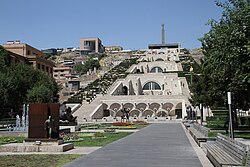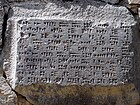Yerevan Cascade
| Yerevan Cascade | |
|---|---|
 The Yerevan Cascade | |
 | |
| General information | |
| Type | staircase |
| Location | |
| Coordinates | 40°11′28″N 44°30′56″E / 40.19111°N 44.51556°E |
| Elevation | 118 m (387 ft) |
| Construction started | 1971 |
| Completed | 1980 |
| Inaugurated | 17 November 2009 |
| Owner | Yerevan Municipality |
| Design and construction | |
| Architect(s) | Jim Torosyan, Aslan Mkhitaryan, Sargis Gurzadyan |
The Cascade (Կասկադ in Armenian) is a building complex in Yerevan, Armenia. It includes terraced gardens connected by extensive staircases, and includes the Cafesjian Museum of Art. Originally planned in the 1920s, some building was undertaken in the 1980s, but construction was suspended several times until 2002. Part of the complex, including the museum and a sculpture garden, was completed in 2009, and work continues to reconstruct and expand the complex.
History
[edit]This section needs to be updated. (May 2018) |
The concept of creating cascading waterfalls and terraced gardens between the two parts of the city was first proposed by architect Alexander Tamanyan, who worked on the project of modern Yerevan in the 1920s. However, the city planner did not live to see the implementation of this concept.
In 1970, 34 years after Alexander Tamanyan's death, the Soviet Union returned to the idea of building the Cascade using the project drafted by the city's chief architect, Jim Torosyan, as well as by Sargis Gurzadyan and Aslan Mkhitaryan. Moscow allocated the funds, since the republic could not cover the costs alone. Torosyan did not fully follow the original plan and made some changes, including the addition of extensive staircases, exhibition halls, courtyards, internal escalators, and various sculptures in the gardens. He wanted to turn this structure into a culturally significant center. Construction started in the 1980s but was interrupted shortly afterwards.[1]
The monument construction was suspended due to a number of events, such as the 1980 Olympic Games in Moscow, which necessitated stopping the construction of many structures throughout the USSR to save funds. Then the earthquake in 1988 and the collapse of the Soviet Union in 1991 followed.[2] White travertine stone was used for building the complex since only this stone was available in the amount sufficient for such a large-scale construction.[citation needed] Construction was then suspended until 2002 due to the lack of funding. The government of the Republic of Armenia decided to reconstruct the existing Yerevan Cascade parts and complete its unfinished sections. The project was initiated by the Cafesjian Museum Foundation, which joined forces with architect David Hotson to develop the project. The museum was opened in 2009 and became the Cafesjian Museum of Art.[3]
Over the next seven years, almost every element of this monument was restored. For the most part, it was converted into the art center named after its key patron, Gerard Cafesjian. The philanthropist donated $128 million to renovate the building. This reconstruction and expansion stage was finished in 2009. At the moment,[when?] there are ten halls in the complex. The third phase, which includes a large glass museum on the upper level and two cinemas (one of them in the museum itself), has just begun[when?] and is still underway.[4]
Description
[edit]The Yerevan Cascade is situated in the northern part of the city center near the Opera House and Matenadaran. It connects the city center with the Victory Park, which commemorates the Soviet Army’s victory over Nazi Germany in World War II. The building covers an area of 78 m2 (840 sq ft).[5]
There is a square on the top of a hill overlooking the Ararat Valley and downtown Yerevan. The park features the Mother Armenia statue that houses a military museum dedicated to the history of World War II and the Nagorno-Karabakh conflict. The Cascade consists of five hillside terraces connected with 572 steps. The building is 302 m (991 ft)high (excluding the 40th Anniversary of Soviet Armenia monument), 50 m (160 ft) wide, and has a total area of 13 ha (32 acres), with a 15-degree slope. The uppermost platform is called the Monumental Terrace. It houses the 40th Anniversary of Soviet Armenia monument, standing 118 m (387 ft) tall.
The terrace consists of a zone bordered by 15 columns symbolically reflecting Armenia's historical heritage. Each floor and sector of the external staircase is a unique work of art. In the inner part of the building, there are elevators and escalators connecting all platforms from the foundation to the top. The entire territory of the architectural heritage is an open-air museum of modern art lying amid the green space. It is a complex of massive stairs with fountains that rise from the Tamanyan Street pedestrian area in the central Kentron district.[6]
Museum
[edit]The building itself houses the Cafesjian Museum of Art, with exhibition halls where permanent and temporary exhibitions are held. The exhibitions are regularly updated to showcase the best specimens of contemporary art and sculpture. The museum includes several galleries, the most notable of them being Gallery One (with works by such glass artists as Ivan Mares, Jaromir Rybak, Pavel Trnka, Jon Kuhn, Herb Babcock, Jan Zorichak, and Bertil Vallien), Khanjyan Gallery, and Eagle Gallery (with works from early collections of art historian Poghos Haytayan, artist Robert Elibekian, and architect Oshin Yeghiazaryan), Sasuntsi Davit Garden Gallery (includes fragments of glass works by the most prominent European glass artists Stanislav Libensky and Jaroslava Brychtova), as well as Eagle Garden and Swarovski galleries.[citation needed] There you can find over 500 works from the collection of the museum founder, Gerard Cafesjian. The museum also houses works by many international artists, such as Fernando Botero, Arshile Gorky, Lynn Chadwick, Jaume Plensa, and Barry Flanagan.[citation needed]
The gallery shop can be accessed via Gallery One.[7]
Sculpture
[edit]Outside the complex, there is a garden integrating works by Britishs sculptor Lynn Chadwick, Barry Flanagan and Paul Cox; Stanislav Libensky and Jaroslav Brychtova (a Czech couple); Jaume Plensa (Spanish Catalan artist and sculptor); and Fernando Botero (Colombian artist). One of the sculptures is dedicated to Alexander Tamanyan, a prominent Yerevan architect. The statue created by Artashes Hovsepyan was officially opened in 1974. Tamanyan bends over a huge slab resting on two smaller stones. According to the sculptor's idea, the left stone symbolizes the old architecture, while the right one is a symbol of a new period of architecture. Thus, Alexander Tamanyan bridged these two periods by building Yerevan, the capital of Armenia.[8]
Some of the sculptures:
- Stairs, Two Watchers, and Sitting Forms by Lynn Chadwick
- Acrobats and Hare on Bell by Barry Flanagan
- Open Window by Stanislav Libensky and Jaroslava Brychtova
- Ahoy — a cartoon-style boat by Paul Cox
- The Cat and Roman Warrior by Fernando Botero
Uses
[edit]The Cafesjian Center for the Arts regularly hosts various events, including lectures, film screenings, and concerts, as well as extensive educational programs for all ages. Since its opening, the number of visitors has reached more than a million people a year.[9]
The Cascade area is also known as a popular year-round venue for meetings and recreation.[10] There are a number of cafes and restaurants on both sides of the Cascade frequented by locals and tourists. Classical and jazz concerts often take place at the Cascade during spring, summer and early autumn, with spectators sitting on the steps.
In addition to providing magnificent views, the building also serves as an outstanding example of architecture.[11]
Gallery
[edit]-
First level
-
Second level
-
Third level
-
Fourth level
-
Fifth level: "Divers" by David Martin
-
Cascade and park
-
"Mujer Fumando un Cigarrillo" by Fernando Botero
-
"The Cat" (Lo Gato) by Fernando Botero
-
"Roman Warrior statue" by Fernando Botero
-
"Shadows I" sculpture by Jaume Plensa
-
Monument to Alexander Tamanian
-
Nighttime view of Yerevan from the Cascade
-
Cascade Memorial and Obelisk, top platform
-
At night
See also
[edit]References
[edit]- ^ "Yerevan Cascade Complex". www.kathmanduandbeyond.com. Retrieved 24 November 2023.
- ^ "YEREVAN CASCADE". architectuul.com. Retrieved 24 November 2023.
- ^ "Yerevan Cascade". architectuul.com. Retrieved 24 November 2023.
- ^ "Yerevan Cascade Complex". www.kathmanduandbeyond.com. Retrieved 24 November 2023.
- ^ "Cascade Pre-History". traveltoarmenia.am. Retrieved 24 November 2023.
- ^ "YEREVAN CASCADE". architectuul.com. Retrieved 24 November 2023.
- ^ "Cascade Pre-History". traveltoarmenia.am. Retrieved 24 November 2023.
- ^ "Cascade Complex". armeniadiscovery.com. Retrieved 24 November 2023.
- ^ "Cascade Pre-History". traveltoarmenia.am. Retrieved 24 November 2023.
- ^ "Cascade complex: Best art environment". www.trip.com/moments. Retrieved 24 November 2023.
- ^ "YEREVAN CASCADE". architectuul.com. Retrieved 24 November 2023.















